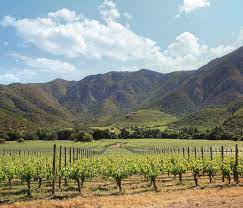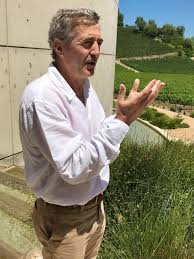Eduardo Chadwick stands as a prominent figure in the Chilean wine industry. Since 1993, he has held the position of President at Viña Errázuriz, a winery deeply rooted in family ownership. Established in 1870 by Don Maximiano Errázuriz, the winery has remained within the family’s grasp, save for a brief period in the 1970s and 80s when it temporarily fell under the ownership of a bank.
Eduardo, in his late 40s, possesses a trim physique, eloquent articulation, and a reserved demeanor that could be likened to a member of the English aristocracy. His accomplishments extend beyond merely building a leading Chilean wine brand from the ground up; he has also been a pioneer in demonstrating that Chile can rival the world’s best wines, dispelling the notion that it is solely about offering value for money. Eduardo’s efforts have given rise to three of Chile’s exclusive “icon wines”: Seña, Don Maximiano, and Viñedo Chadwick. I had the privilege of visiting him at the Viñedo Chadwick estate, located in the southern outskirts of Santiago, alongside fellow colleagues who were judging Chile’s annual wine awards.
Originally spanning 400 hectares of open countryside, the Viñedo Chadwick property underwent a significant transformation in 1960 due to Chilean government-imposed land reform policies. These policies restricted landowners to a maximum of 80 “basic” hectares, and as a result, the Chadwicks in Maipo were permitted to retain only 40 hectares, necessitating the sale of the remaining land. Eduardo’s father, Alfonso, anticipated this move and sold portions of the land to Concha y Toro (now known as the Almaviva property) and Cousino Macul. Simultaneously, Errazuriz expanded to 500 hectares, only to be divided into 35 distinct parcels, leaving Viña Errazuriz with just 15 hectares and the winery. Economic challenges led to the closure of the Errazuriz winery in 1970, and it changed hands between banks until Alfonso Chadwick reclaimed it in 1983, inviting his 23-year-old son Eduardo to manage it.
Thus, from 1983 to 1992, Eduardo devoted his efforts to the formidable task of rebuilding a once-thriving brand. All he had at his disposal was the name, an aging winery in Aconcagua, and 15 contiguous hectares of pergola vineyards. A significant part of his challenge was to develop new vineyard sites in Casablanca and the coastal region of Aconcagua. One of his noteworthy achievements was introducing Syrah to Chile in the early 1990s, shifting the country’s focus away from Bordeaux varietals. In 1994, he grafted Syrah onto old vine Cabernet in Aconcagua, leading to the rapid growth of Syrah cultivation in Chile, with 2500 hectares dedicated to it.
In 1990, renowned Californian winemaker Robert Mondavi visited Chile and fell in love with the country. This encounter led to a Mondavi/Chadwick joint venture in 1995, resulting in the creation of Seña, Chile’s inaugural “icon” wine, released in 1997. Initially produced from other vineyard sources, a dedicated property in Aconcagua was identified and developed in 1999. The joint venture also included Caliterra in Colchagua and the Arboleda range of boutique wines from specific terroirs, all coexisting alongside Errazuriz. When Constellation acquired Mondavi in 2003, Eduardo exercised his first refusal rights and reclaimed these ventures, contributing to his extensive portfolio of responsibilities. Seña now exclusively sources grapes from a 350-hectare hillside property managed under biodynamic principles, with Alan York as a consultant. It is in the process of becoming certified as an organic vineyard, with plans to fully transition to biodynamics over time. Six wineries in Chile have formed a biodynamic association, and Eduardo believes that Chile has unparalleled potential for organic and biodynamic viticulture, although the effects of biodynamics on the wines are yet to be fully realized.
Viñedo Chadwick, situated in Alto Maipo, originally served as a family residence. Eduardo’s father, Alfonso Chadwick Errázuriz, was an avid polo player, and much of the property was dedicated to this pursuit. Eduardo moved to the estate in 1992, a year before his father’s passing, and made the challenging decision to convert the polo field into a vineyard. Over 30 hectares were planted with Cabernet Sauvignon, Merlot, and Cabernet Franc. In an unexpected turn, Eduardo initially mistook Carmenère for Merlot and later removed the problematic Carmenère vines after several years of declassification. As of now, Viñedo Chadwick exclusively produces Cabernet, although newly planted Merlot and Cabernet Franc may be incorporated into the blend in the future.
The vineyard enjoys an elevated plateau at 700 meters, with frost posing a potential risk. Harvest typically occurs at the end of April or early May. Eduardo recalls an attempt to expand Merlot cultivation a decade ago, importing clones 101 and 181 and planting them on their own roots, as is the tradition in Chile. However, this venture proved challenging due to poor root systems, a contrast to European vines that are typically grafted. Eduardo has since planted grafted Merlot, but acknowledges the difficulties associated with cultivating high-quality Merlot. The inaugural release of Viñedo Chadwick, in 1999, featured grapes from 8-year-old vines, and approximately 700 cases are produced on average each year.
Av. Sta. Rosa 14715
Puente Alto
Región Metropolitana
Chile

